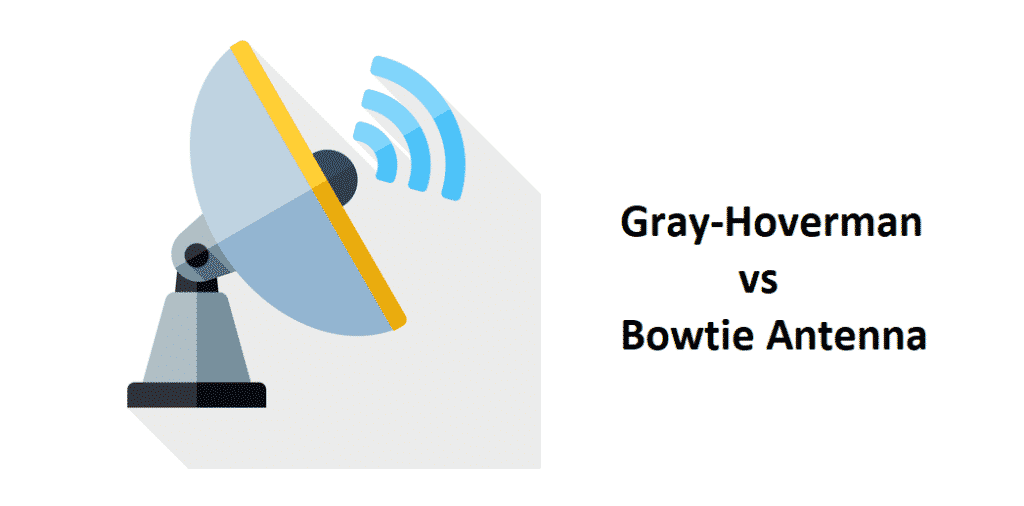
There was a time when your sibling had to rotate the antenna around to get the desired channels and resolution. However, the advent of technology has improved the antennas since they are regulated and promise streamlined channel broadcasting.
So, in this article, we are sharing Gray-Hoverman Vs. Bowtie Antenna will allow you to make an effective choice.
Gray-Hoverman vs Bowtie Antenna
Bowtie Antenna
First things first, this antenna is designed to meet the diverse needs of the users since it has been designed in different styles. For instance, the antenna is available in 45-mile, 70-mile, 60-mile, 70-mile with 30-inches mount, and the 70-mile with HDTV preamplifier. In addition, it’s available in 70-mile with the VHF kit that caters to the diverse needs of the users.
The antenna is designed with brackets that are safe for turning the antennas panels which will provide seamless access to the US channels, ranging from 14 to 69. With this Bowtie antenna, the users will get free TV network coverage, such as CBS, Fox, ABC, Univision, NBC, and MeTV. The best thing is that all the channels are available in 1080 resolution (yes, even the free ones).
The antenna has been curated with a multi-purpose arrangement that promises easy setup and installation. Also, it provides flexibility in choosing directions. When you buy this antenna, it comes with all-weather hardware, so you don’t have to replace the antenna after heavy winds or rain. All the parts come with a lifetime warranty, so that’s a steal for sure!
This antenna is a fine choice for weak signal issues and it can offer access to the long-haul stations without causing any interference. The bowtie design on this antenna helps capture an array of frequencies while receiving the UHF stations. As far as the build is concerned, it’s pretty huge and the antennas are mounted in the central area.
The best thing about this antenna is that it allows the users to set up and arrange the antenna in a variety of ways, be it left or right. With this being said, the signal reception will only increase without compromising on the programming. As far as the suitability is concerned, the Bowtie antenna is suitable for the areas where stations are rather weak.
When it comes down to the performance, this antenna will seamlessly receive more than fifty stations without compromising on the resolution. As for the cabling, we suggest utilizing the coaxial cables for power purposes since it optimizes better signal transfer. The users are usually dreading the assembly, but this antenna usually comes assembled for easy and quick setup.
Also, while installing, keep in mind that the mast must be properly screwed in the place because the antenna is pretty heavy. Lastly, don’t install the antenna around the wires because it can disrupt the signals and frequencies.
Gray-Hoverman Antenna
For everyone who needs diversity in the distance coverage, this antenna is designed with the 75 miles to 100 miles range. Initially, this antenna was only responsible for receiving the UHF band but with the tech improvements, this antenna has capacity for VHF-Hi as well (pretty impressive). The antenna is designed with the easy build in mind since it has the DIY configuration.
The antenna is suitable for the different frequencies and signals, such as ISDB-T, TV, ATSC, and more. When it comes down to the build, there are no restrictions since it can be built with copper or aluminum, whatever you like. However, the diameter must range from three-mm to eight-mm since it provides better gain and reception.
During the setup, it is suggested that you directly use the coaxial cables for streamlined connectivity. As for the central wire, it must be installed on the element. To be honest, the performance is not top-notch but you can use the reflectors for taking care of the performance issue. Even more, you will be responsible for the entire setup.
The Bottom Line
The bottom line is that the Gray-Hoverman antenna is only suitable for tech-savvy people because it’s the DIY antenna and demands intricate knowledge and building. On the other hand, the bowtie antenna is relatively easy to set up since it comes all assembled and can take the wear and tear as well.